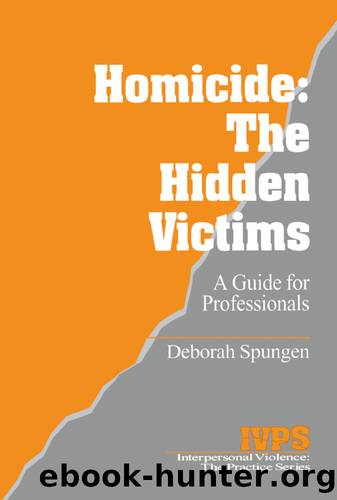Homicide: the Hidden Victims by Spungen Deborah;

Author:Spungen, Deborah;
Language: eng
Format: epub
ISBN: 1598498
Publisher: SAGE Publications, Incorporated
Published: 1997-10-08T00:00:00+00:00
* * *
Crime Scene Clean-Up, Inc., a company that specializes in disposing of blood, body fluids and decomposed remains . . . [reports that] business is so good that four months ago, they opened a second office in Fairless Hills, Bucks County. (Cipriano, 1996, p. A3)
In a commercial establishment, an office, or a school, on-site maintenance personnel may be called on to do the work. This can be problematic if the staff knew the victim. It may be helpful to bring in outside personnel in such situations. In any case, debriefing of these personnel should be done after the cleanup is completed.
Photographs. Photographs are usually taken of the deceased at the crime scene. These are for use by the homicide detective, prosecutor, and medical examiner and may be used as evidence at the murder trial. A co-victim might ask to view these photographs immediately or at a later time. This can become an area of contention, especially between the police, the prosecutor, and the co-victim. The request may be denied in an effort to protect the co-victim or because there is no understanding of why the co-victim may want to see the photographs. The co-victim should not have to justify this request. If the photographs cannot be shown until after the trial, then this should be explained and any decision to show them postponed until after the criminal justice proceedings are complete. This issue can be handled in a kind and sensitive manner. Officials can retain control of the situation while allowing co-victims to feel that they still have some control. Some description of the photographs should be given so co-victims can decide if they still want to view them.
The photographs should be viewed in a quiet, safe, and private place. Everyone involved needs to understand that co-victims will become upset on viewing the photographs. For this reason, co-victims may wish to have other family members, a victim advocate, or a mental health professional accompany them, or at the least, provide transportation. The best way to present the photographs is to show them one at a time, not all spread out. In this way, the co-victim can be asked after each photograph, âDo you want to see another one?â The person may find that it is sufficient to see only one or two photographs. Co-victims are more likely to make this decision if they have been informed that the photographs will still be available for viewing at a later time and will not be destroyed.
Crime scene visits. The crime scene often plays an important role to the co-victims as they begin to process the event. Some co-victims want to view the location of the death. This request is usually made to law enforcement personnel in the immediate aftermath of the homicide or even days or weeks later. Opinions vary from one jurisdiction to another about allowing these visits. In one place, the police may ask co-victims if they would like to go to the scene and offer to transport them. In another jurisdiction, the police may be reluctant to sanction such visits.
Download
This site does not store any files on its server. We only index and link to content provided by other sites. Please contact the content providers to delete copyright contents if any and email us, we'll remove relevant links or contents immediately.
The Secret History by Donna Tartt(18065)
The Social Justice Warrior Handbook by Lisa De Pasquale(11934)
Thirteen Reasons Why by Jay Asher(8402)
This Is How You Lose Her by Junot Diaz(6405)
Weapons of Math Destruction by Cathy O'Neil(5785)
Zero to One by Peter Thiel(5450)
Beartown by Fredrik Backman(5296)
The Myth of the Strong Leader by Archie Brown(5208)
The Fire Next Time by James Baldwin(4993)
How Democracies Die by Steven Levitsky & Daniel Ziblatt(4936)
Promise Me, Dad by Joe Biden(4893)
Stone's Rules by Roger Stone(4823)
100 Deadly Skills by Clint Emerson(4653)
Rise and Kill First by Ronen Bergman(4531)
A Higher Loyalty: Truth, Lies, and Leadership by James Comey(4525)
The David Icke Guide to the Global Conspiracy (and how to end it) by David Icke(4352)
Secrecy World by Jake Bernstein(4347)
The Farm by Tom Rob Smith(4296)
The Doomsday Machine by Daniel Ellsberg(4224)
